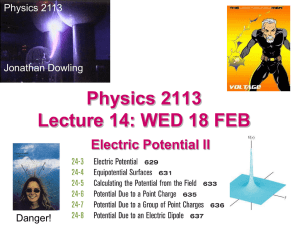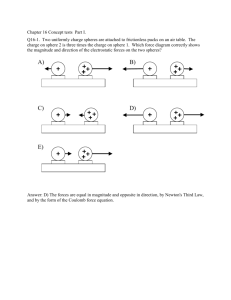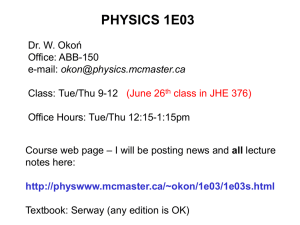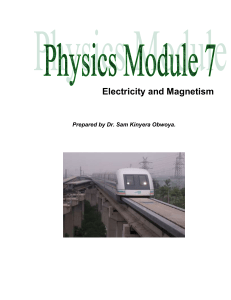class xii-sci-phy - KENDRIYA VIDYALAYA RECKONGPEO
advertisement
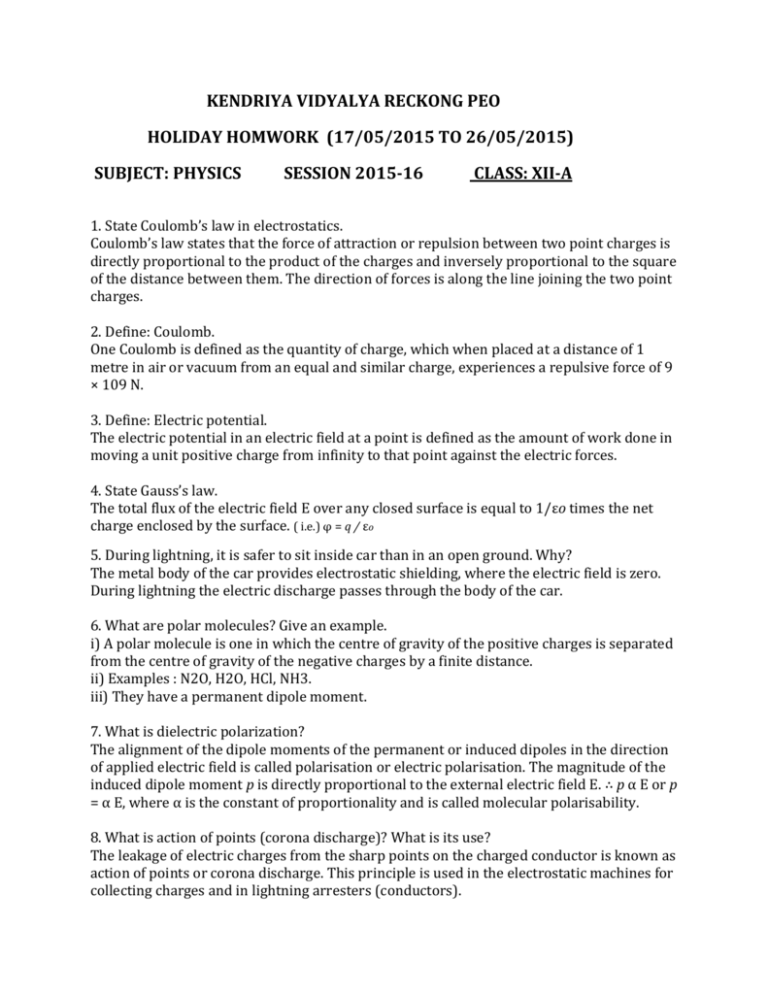
KENDRIYA VIDYALYA RECKONG PEO HOLIDAY HOMWORK (17/05/2015 TO 26/05/2015) SUBJECT: PHYSICS SESSION 2015-16 CLASS: XII-A 1. State Coulomb’s law in electrostatics. Coulomb’s law states that the force of attraction or repulsion between two point charges is directly proportional to the product of the charges and inversely proportional to the square of the distance between them. The direction of forces is along the line joining the two point charges. 2. Define: Coulomb. One Coulomb is defined as the quantity of charge, which when placed at a distance of 1 metre in air or vacuum from an equal and similar charge, experiences a repulsive force of 9 × 109 N. 3. Define: Electric potential. The electric potential in an electric field at a point is defined as the amount of work done in moving a unit positive charge from infinity to that point against the electric forces. 4. State Gauss’s law. The total flux of the electric field E over any closed surface is equal to 1/εo times the net charge enclosed by the surface. ( i.e.) φ = q / εo 5. During lightning, it is safer to sit inside car than in an open ground. Why? The metal body of the car provides electrostatic shielding, where the electric field is zero. During lightning the electric discharge passes through the body of the car. 6. What are polar molecules? Give an example. i) A polar molecule is one in which the centre of gravity of the positive charges is separated from the centre of gravity of the negative charges by a finite distance. ii) Examples : N2O, H2O, HCl, NH3. iii) They have a permanent dipole moment. 7. What is dielectric polarization? The alignment of the dipole moments of the permanent or induced dipoles in the direction of applied electric field is called polarisation or electric polarisation. The magnitude of the induced dipole moment p is directly proportional to the external electric field E. ∴ p α E or p = α E, where α is the constant of proportionality and is called molecular polarisability. 8. What is action of points (corona discharge)? What is its use? The leakage of electric charges from the sharp points on the charged conductor is known as action of points or corona discharge. This principle is used in the electrostatic machines for collecting charges and in lightning arresters (conductors). 9. Give any 3 properties of electric lines of force. Properties of lines of forces: (i) Lines of force start from positive charge and terminate at negative charge. (ii) Lines of force never intersect. (iii) The tangent to a line of force at any point gives the direction of the electric field (E) at that point. 10. State the law of conservation of electric charges. The total charge in an isolated system always remains constant. For example, Uranium (92U238) can decay by emitting an alpha particle (2He4 nucleus) and transforming tothorium (90Th234). 92U238 −−−−→ 90Th234 + 2He4 Total charge before decay = +92e, total charge after decay = 90e + 2e. Hence, the total charge is conserved. i.e. it remains constant. 11. In the given circuit, what is the effective capacitance between A and B. 12. What is an electric dipole? Define: the dipole moment. Two equal and opposite charges separated by a very small distance constitute an electric dipole. Examples : Water, ammonia, carbon−dioxide and chloroform molecules The dipole moment is the product of the magnitude of the one of the charges and the distance between them. ∴ Electric dipole moment, p = q2d or 2qd. It is a vector quantity and acts from –q to +q. The unit of dipole moment is C m. 13. Define: Electric flux. Give its unit. The electric flux is defined as the total number of electric lines of force, crossing through the given area. Its unit is N m2 C−1. 14. What is electrostatic shielding? i) It is the process of isolating a certain region of space from external field. ii) It is based on the fact that electric field inside a conductor is zero. 15. Three capacitors each of capacitance 3 pF are connected in parallel. Find effective capacitance. (M – 08) The effective capacitance Cp = C1 + C2 + C3 = 9 + 9 + 9 = 27 Pf 16. What are non-polar molecules? Give an example. i) A non-polar molecule is one in which the centre of gravity of the positive charges coincide with the centre of gravity of the negative charges. ii) Example: O2, N2, H2. iii) The non-polar molecules do not have a permanent dipole moment. 17. What is a capacitor? Define: capacitance. i) A capacitor is a device for storing electric charges. ii) The capacitance of a conductor is defined as the ratio of the charge given to the conductor to the potential developed in the conductor. 18. What is microwave oven? How it works? Microwave oven It is used to cook the food in a short time. When the oven is operated, the microwaves are generated, which in turn produce a non-uniform oscillating electric field. The water molecules in the food which are the electric dipoles are excited by an oscillating torque. Hence few bonds in the water molecules are broken, and heat energy is produced. This is used to cook food. 19. Write the applications of a capacitor. Applications of capacitors. (i) They are used in the ignition system of automobile engines to eliminate sparking. (ii) They are used to reduce voltage fluctuations in power supplies and to increase the efficiency of power transmission. (iii) Capacitors are used to generate electromagnetic oscillations and in tuning the radio circuits. 20. What do you mean by additive nature of charges ? Give an example. Additive nature of charge The total electric charge of a system is equal to the algebraic sum of electric charges located in the system. For example, if two charged bodies of charges +2q, −5q are brought in contact, the total charge of the system is –3q. 21. Find the electric potential at a distance 0.09 m from a charge of 4 X 10-7 C. ( M – 12 ) The 1. What is an intrinsic semiconductor? Give any two examples. A semiconductor which is pure and contains no impurity is known as an intrinsic semiconductor. In an intrinsic semiconductor, the number of free electrons and holes are equal. Common examples of intrinsic semiconductors are pure germanium and silicon. electric potential V = ( 1/4πεo ) q /r = ( 9 X 10 9 X 4 X 10 -7)/ 9 X 10 -2 = 4 X 104 volt. 2. Define P-type and n- type semiconductors. 3. Differentiate between metals, insulators and semiconductors on the basis of band theory of solids.



